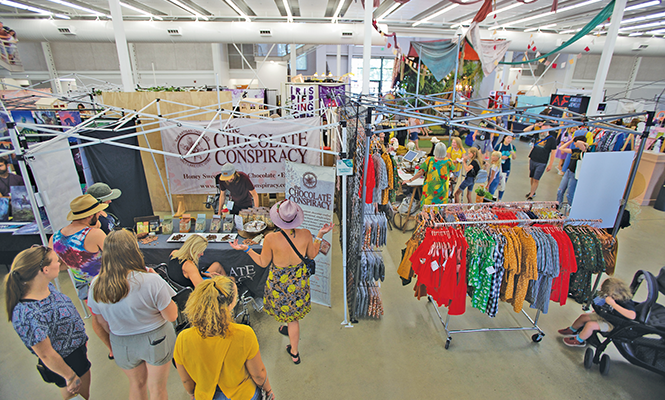
If anything has been true of the past two years of COVID-era life, it’s that people have been forced to think creatively. Where the Craft Lake City DIY Festival is concerned, that creativity has manifested itself in many ways.
For this 14th annual showcase of local makers and artisans, the event returns to the Utah State Fairpark, where it moved in 2019 to provide growing room and continued last year after moving to a unique online format for 2020. That 2020 experience, however—according to SLUG publisher and Craft Lake City founder Angela Brown—was itself a magnificent example of DIY spirit.
When it became clear that an in-person event would not be possible in the summer of 2020, Brown turned towards virtual options, yet also knew that she wanted something different. “We didn’t know what to do, but we didn’t want to do what others were doing—just making a landing page driving folks to peoples’ accounts,” Brown says. “We wanted it to be like a video-game platform, make it really engaging.”
The result was a full-fledged virtual-reality environment created with a Mozilla platform. Each artisan got their own virtual room—which Craft Lake City staff had to teach them in just 30 days how to create—where visitors could enter with avatars and look around. And according to Brown, it was so popular on the festival’s first night that it crashed the Mozilla servers.
That doesn’t mean it was a problem-free experience, of course. Brown describes the sales for the artisans as “feast or famine,” with some doing pretty well and others selling nothing at all. In part, that was the result of the virtual “rooms” taking up so much virtual space that, if the square footage had existed in the real world, it would have been three times the size of the actual festival. That meant that, due to the loading speed of the rooms, a typical visitor might only have the opportunity to visit 20 rooms, rather than perhaps seeing every stall at the in-person festival.
Still, Brown considers the experience a valuable one, bringing a different demographic to the event and allowing visitors from other states. But it was a relief to everyone to return to an in-person event in 2021, albeit one that allowed vendors to be either indoors or outdoors based on comfort level. “We bounced back really well,” Brown says, “even if the attendance was 15,000 or 16,000 compared to the pre-COVID around 20,000.”
For all the disruption caused by the pandemic, Brown believes that the “great pause” was an opportunity for more makers to be born, or for existing makers to expand the kind of work they do. “We’ve definitely seen that and heard that from participants, that they either found their craft during the pandemic, or worked better,” Brown says. “For a lot of people, now they have a side hustle. The pandemic really did help people find that. … Regulars did expand their inventory, picking up a new skill and adding that to their booths. We have one artisan who previously did screen-printed posters, now also does screen printed pillows. [The shutdown allowed people to] get creative with their skills.”
For 2022, there’s a hope that things are a bit more “normal” for the DIY festival, though Brown says that there are always new things to add. On the guest-facing side, for the second year the festival grounds will allow guests to bring in well-trained dogs, and is adding a Sunday “barnburner dance party” featuring DJ Jesse Walker of New City Movement. More behind-the-scenes, the DIY festival has developed a new scholarship in conjunction with Project Rainbow, subsidizing the participation fees for queer-identifying artists who make queer-themed work, as part of Craft Lake City’s inclusion efforts.
But one thing that remains constant is that idea of inspiring creativity—not just for those who are part of the staff, or the artisans at their booths, but for those who attend. Brown has seen plenty of evidence over the years that visitors to the DIY Festival often leave with an itch to become creators themselves.
“We hear that time and time again,” Brown says. “Every year there’s a new artisan that I meet, there for the first time, who says ‘I went last year, I was so surprised, I found my community.’ One story I love to tell involves someone who came to the very first [DIY festival]. He went home that night and Googled ‘how to make paper.’ He taught himself how to make handmade paper that night, and he was there [at the DIY festival] the next year selling it. So we hear that all the time: ‘I don’t know if I can do anything, but I want to try.'”